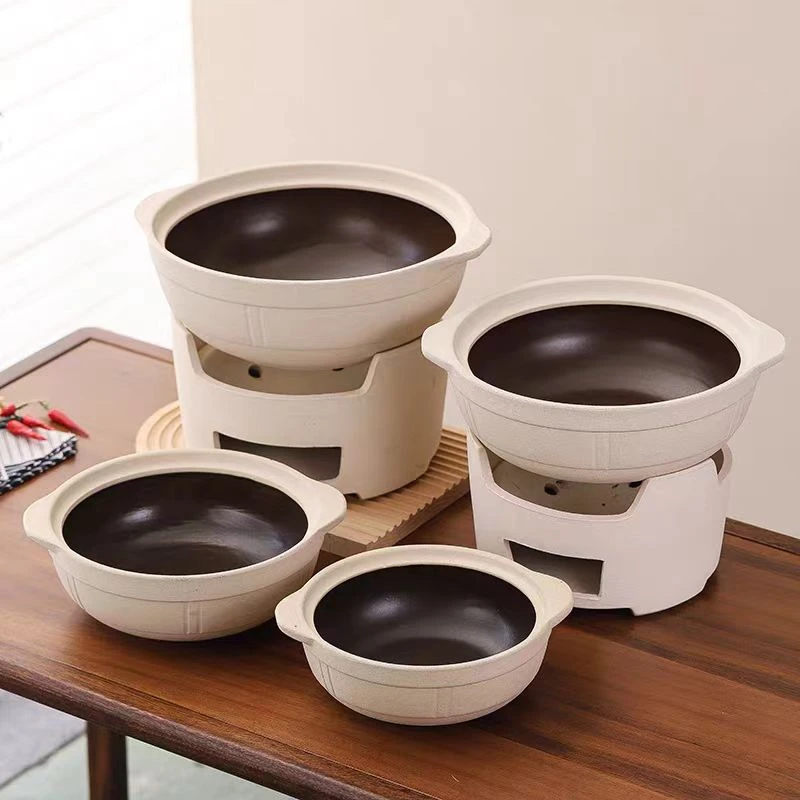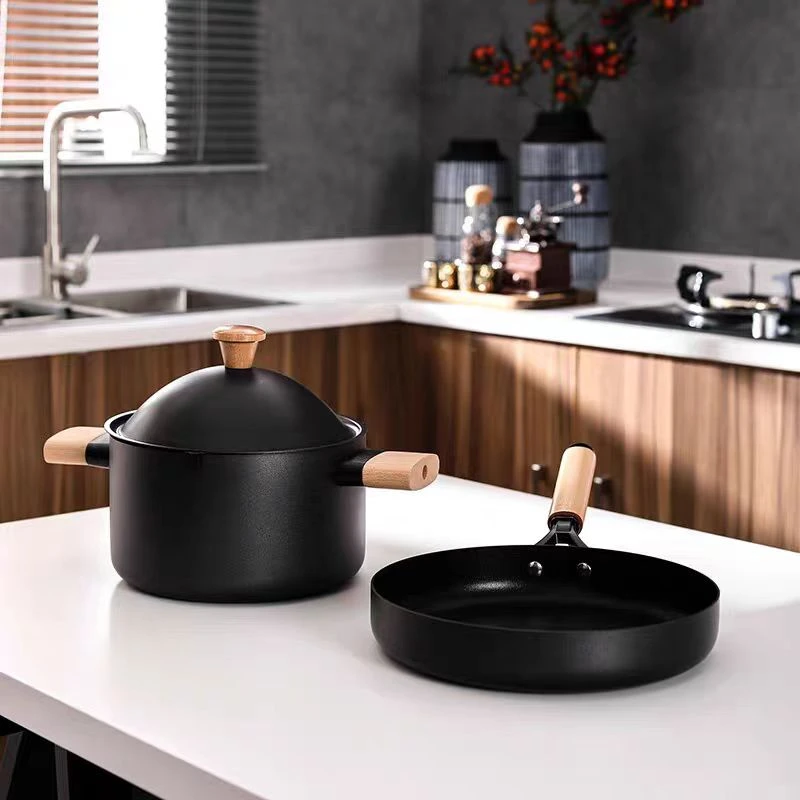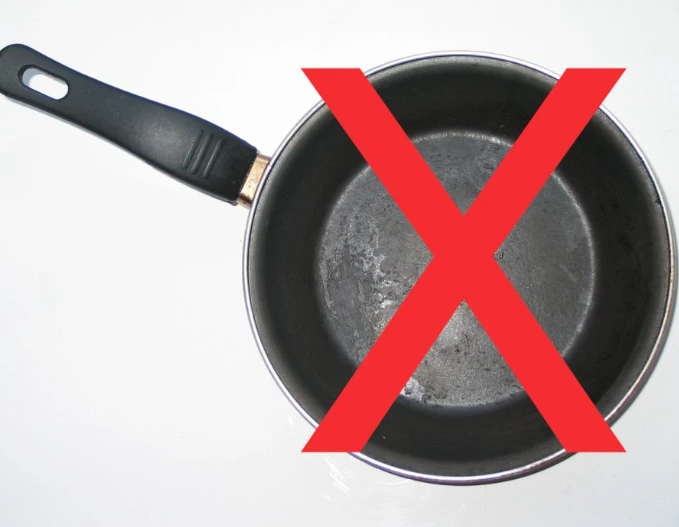In home cooking, in addition to choosing high-quality ingredients, the safety of cookware also directly affects our health. Some cookware may release harmful substances at high temperatures, and long-term use will have adverse effects on the body. So, what kind of cookware are truly 100% non-toxic? As a 卸売調理器具メーカー, I will analyze the 4 safest cookware in detail for you to help you create a healthy and non-toxic kitchen.

Comparison of 4 Types of Non-Toxic Cookware
| Cookware Material | Non-Toxic Reason | Health Benefits | Drawbacks |
| Pure Ceramic Cookware | Made from natural materials, free from chemical coatings or harmful substances like PTFE, PFOA, lead, and cadmium | Does not release harmful substances; suitable for high-temperature cooking | Expensive, fragile, requires careful handling |
| ステンレス調理器具 | Free from chemical coatings, highly corrosion-resistant, does not react with food | Durable, suitable for frying, sautéing, and simmering | Low-quality stainless steel may leach nickel or other metals; high-quality options recommended |
| Cast Iron Cookware | Free from chemical coatings; naturally develops a non-stick surface | Adds dietary iron, ideal for high-temperature cooking | Requires regular maintenance, prone to rust, not ideal for prolonged acidic cooking |
| Carbon Steel Cookware | Develops a natural seasoning layer for a non-toxic, non-stick surface, free from chemical coatings | Lightweight, ideal for high-temperature cooking | Needs maintenance to prevent rust; seasoning layer requires periodic 1renewal |

Non-Toxic Cookware 1: Pure Ceramic Cookware
Pure ceramic cookware (not ceramic coated) is considered one of the safest cookware on the market because it is completely non-toxic and environmentally friendly.
Non-toxic reasons
Pure ceramic is made entirely of natural minerals and does not contain any artificial chemicals or coatings. It is completely free of potentially harmful substances such as PTFE (polytetrafluoroethylene), PFOA (perfluorooctanoic acid), lead and cadmium, so it does not release harmful gases or chemicals.
Health advantages
Pure ceramic cookware can still maintain its stability in high temperature environments, ensuring that no harmful substances will seep out during cooking. In addition, ceramic materials have excellent heat preservation properties, can evenly distribute heat, and reduce the damage to nutrition caused by local overheating.
Disadvantages
Fragility: Ceramics are prone to breakage when encountering hard objects or drastic changes in high and low temperatures, so they need to be used and stored more carefully.
Heavy weight: Some pure ceramic products may be heavy and are not suitable for cooking methods that require frequent stir-frying.
Applicable scenarios
It is very suitable for soups, stews or slow cooking at low temperatures, which can preserve the original flavor of food to the greatest extent.

Non-Toxic Cookware 2: Stainless Steel Cookware
Non-toxic reasons
ステンレス調理器具 has no chemical coating and is highly resistant to corrosion. High-quality stainless steel does not release harmful metal ions, especially under normal cooking conditions.
Health advantages
汎用性がある: Suitable for a variety of cooking methods, such as frying, stir-frying, steaming, and boiling.
掃除がしやすい: The surface of stainless steel is smooth, not easy to adhere to food residues, and easy to clean after use.
高い耐久性: Stainless steel has good scratch resistance and can withstand high temperatures and high-intensity use.
Disadvantages
Nickel and chromium content: Low-quality stainless steel may contain higher nickel or chromium components, which may be released in small amounts when cooking acidic foods, and long-term use may affect sensitive people. Therefore, stainless steel products marked with food grade and certification should be selected.
General thermal conductivity: Stainless steel itself has weak thermal conductivity, and usually requires the addition of aluminum or copper interlayers to improve thermal conductivity.
Applicable scenarios
Stainless steel cookware is suitable for daily frying, stir-frying, stewing, and also suitable for environments such as restaurant kitchens that require durability and efficiency.

Non-Toxic Cookware 3: Cast Iron Cookware
Cast iron cookware is a classic choice in the culinary world because of its excellent durability and naturally non-toxic properties.
Why it’s non-toxic?
Cast iron cookware does not contain any chemical coatings, and a protective layer naturally forms during use to prevent direct contact between the iron and food. In addition, this natural protective layer also helps prevent food from sticking to the pan.
Health advantages
Iron Supplement: Small amounts of iron may be released during cooking, especially when stewing, which is an additional healthy supplement for some people who are iron deficient.
High Temperature Resistance: Cast iron pans can withstand extremely high temperatures, making them ideal for frying, stewing, and baking.
Even Heat: Cast iron cookware has strong heat retention and can evenly distribute heat, making it suitable for recipes that require slow cooking.
Disadvantages
Heavy Weight: Cast iron pans are usually bulky and not suitable for stir-frying.
Maintenance Required: Cast iron pans are prone to rusting or losing their natural non-stick properties if not properly maintained.
Not Suitable for Acidic Foods: Cooking acidic foods for a long time may damage the protective layer and even cause excessive iron release.
Applicable scenarios
Cast iron cookware is suitable for stewing, baking and outdoor cooking, very suitable for dishes that require a long cooking time.

Non-Toxic Cookware 4: Carbon steel cookware
Carbon steel cookware is becoming an increasingly popular healthy choice with its lighter weight and similar properties to cast iron.
Non-toxic reasons
Carbon steel cookware provides non-stick properties through a naturally formed seasoning layer, completely independent of any chemical coating.
Health advantages
High temperature stability: Suitable for high-temperature stir-frying and frying without worrying about the release of harmful substances.
軽量だ: Lighter than cast iron, easy to stir-fry and move.
Rapid heating: Carbon steel heats up quickly, suitable for quick stir-fry dishes.
Disadvantages
Rust-prone: Carbon steel is prone to oxidation if not cleaned in time or stored properly.
Seasoning layer needs maintenance: The seasoning layer may wear out over time and needs to be re-seasoned regularly to maintain performance.
Applicable scenarios
Carbon steel cookware is great for Chinese stir-frying, quick stir-frying and outdoor barbecue, especially for chefs who like high-temperature cooking.

Healthy Cookware Selection Tips
Choose the most suitable non-toxic cookware according to different cooking needs and budget:
- Users who prefer slow cooking or high-temperature cooking can choose cast iron or pure ceramic;
- High-quality stainless steel is recommended for daily multi-purpose cookware;
- Chefs who prefer lightness and high-temperature stir-frying can try carbon steel;
- Families who prefer healthy eating and low-oil cooking can choose ceramic-coated cookware.
Which Cookware Materials Should Be Avoided?
Traditional non-stick cookware: Non-stick pans using PTFE (Teflon) or PFOA may release harmful gases at high temperatures.
Cheap aluminum cookware: Aluminum pans that have not been anodized may ooze metal during cooking, especially with acidic foods.
Poor quality enamel cookware: Low-quality enamel coatings can easily fall off, exposing potentially harmful metals.

How To Choose 100% Non-Toxic Kitchenware?
- Pay attention to certification: Give priority to products that have passed the harmless chemical certification, such as those marked “PTFE, PFOA-free”.
- Choose well-known brands: Brand reputation is usually linked to product quality and is worth investing in.
- Suitable for use: Choose the right material according to personal cooking needs, such as stainless steel or cast iron for frying, and ceramic coating for low-oil cooking.
概要
Truly 100% non-toxic kitchenware includes pure ceramic, stainless steel, cast iron, spring steel and other materials. They do not contain any harmful chemicals and can provide you and your family with a healthier cooking experience. By choosing high-quality and safe kitchenware, you can enjoy delicious food more safely while protecting the health of your family.
